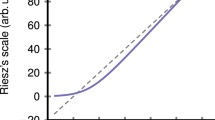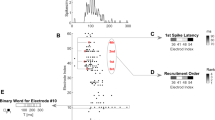Abstract
-
1.
To determine reliability of stimulus intensity coding we measured the response variability of 30 hydroxy-L-proline sensitive chemoreceptor cells from antennules of Homarus americanus. First, cells were tested with 5 repeated presentations of 10-5 M and l0-4 M hydroxy-L-proline. Then a stimulus response function was determined in each cell from l0-6to 5 × l0-4 M in half log steps.
-
2.
Population mean responses to repetitive stimulation showed little variability and mean stimulus response functions increased monotonically. In contrast, most individual cells showed a high response variability and no single cell stimulus-response function increased monotonically. The greatest response variability occurred between different cells.
-
3.
Mean response magnitude of a 30 cell population allowed reliable discrimination between 10-5 M and l0-4 M hydroxy-L-proline for each of the 5 repetitions. It also allowed discrimination of all concentrations of hydroxy-L-proline tested. Across-fiber response patterns also differed significantly with concentration while they remained relatively stable with repetition of the same stimulus.
-
4.
We applied different analytical methods to test the reliability of response magnitude and across-fiber pattern as possible codes for intensity discrimination. We demonstrated that a random population of rather unreliable receptor cells could provide remarkably reliable intensity information to the CNS based on response magnitude or across-fiber pattern.
Similar content being viewed by others
Abbreviations
- AFP:
-
Across-Fiber Pattern (AFPs = plural)
- ASW:
-
Artificial Seawater
- CV:
-
Coefficient of Variation (CVs = plural)
- GCV:
-
Grand Coefficient of Variation
- GMRM:
-
Grand Mean Response Magnitude
- Hyp:
-
trans-4-hydroxy-L-proline, Hyp cells primary chemoreceptor cells sensitive to Hyp
- IRC:
-
Intensity Response Characteristic
- MDS:
-
Multi-Dimensional Scaling
- MRM:
-
Mean Response Magnitude (spikes/s) (MRMs = plural)
- NMD:
-
Neural Mass Differences, RM Response Magnitude (spikes/s) (RMs = plural)
- SEM:
-
Standard Error of the Mean (SEMs = plural)
- SD:
-
Standard Deviation (SDs = plural)
- S-R:
-
Stimulus-Response
- TRM:
-
Total Response Magnitude (TRMs = plural); Subscripts (as used with CV and MRM)
- C:
-
within a cell (intra-cell)
- P:
-
within the population (inter-cell)
References
Ache BW, Derby CD (1985) Functional organization of olfaction in crustaceans. Trends Neurosci 8: 356–360
Atema J (1985) Chemoreception in the sea: adaptations of chemoreceptors and behavior to aquatic stimulus conditions. Soc Exp Biol Symp 39: 387–423
Atema J, Borroni PF, Johnson BR, Voigt R, Handrich L (1989) Adaptation and mixture interactions in chemoreceptor cells: mechanisms for diversity and contrast enhancement. In: Laing DL, Cain W, McBride R, Ache BW (eds) Perception of complex smells and tastes. Academic Press, Sydney, pp 83–100
Derby CD, Atema J (1982) The function of chemo- and mechanoreceptors in lobster (Homarus americanus) feeding behavior. J Exp Biol 98: 317–327
Derby CD, Atema J (1988) Chemoreceptor cells in aquatic invertebrates: peripheral mechanisms of chemical signal processing in decapod Crustacea. In: Atema J, Popper AN, Fay RR, Tavolga WN (eds) Sensory biology of aquatic animals. Springer, Berlin Heidelberg New York, pp 365–385
Dethier DV (1968) Chemosensory input and taste discrimination in the blowfly. Science 161: 389–391
Dethier DV (1971) A surfeit of stimuli: a paucity of receptors. Am Sci 59: 706–715
Dethier DV (1974) The specificity of the labellar chemoreceptors of the blowfly and the response to natural foods. J Insect Physiol 20: 1859–1869
Devine DV, Atema J (1982) Function of chemoreceptor organs in spatial orientation of the lobster, Homarus americanus: differences and overlap. Biol Bull 163: 144–153
DiLorenzo PM (1989) Across unit patterns in the neural response to taste: vector-space analysis. J Neurophysiol 62: 823–833
Fine-Levy JB, Daniel PC, Girardot M-N, Derby CD (1989) Behavioral resolution of quality of odorant mixtures by spiny lobsters: Differential aversive conditioning of olfactory responses. Chem Senses 14: 503–524
Fuzessery ZM, Carr WES, Ache BW (1978) Antennular chemosensitivity in the spiny lobster, Panulirus argus: studies of taurine sensitive receptors. Biol Bull 154: 226–240
Gill JM, Erickson RP (1985) Neural mass differences in gustation. Chem Senses 10: 531–548
Girardot MN, Derby CD (1988) Neural coding of quality of complex olfactory stimuli in lobsters. J Neurophysiol 60: 303–324
Gomez G, Voigt R, Atema J (1992) High resolution measurement and control of chemical stimuli in the lateral antennule of the lobster Homarus americanus. Biol Bull 183: 353–354
Govind CK, Lang F (1981) Physiological identification and asymmetry of lobster Homarus americanus claw closer moto neurons. J Exp Biol 94: 329–339
Hanson FE, Kogge S, Cearly C (1986) Computer analysis of chemosensory signals. In: Birch M, Payne T, Kennedy C (eds) Mechanisms in insect olfaction. Oxford University Press, pp 269–278
Johnson BR, Atema J (1983) Narrow-spectrum chemoreceptor cells in the antennules of the American lobster, Homarus americanus. Neurosci Lett 41: 145–150
Johnson BR, Merrill CL, Ogle RC, Atema J (1988) Response properties of lobster chemoreceptors: tuning of olfactory neurons sensitive to hydroxy-proline. J Comp Physiol A 162: 201–211
Johnson BR, Voigt R, Atema J (1989) Response properties of lobster chemoreceptors: binary mixture interactions and cross-adaptation in primary olfactory receptor cells. Physiol Zool 62: 559–579
Johnson BR, Voigt R, Merrill CL, Atema J (1991) Across-fiber patterns may contain a sensory code for stimulus intensity. Brain Res Bull 26: 327–331
Merrill CL, Voigt R, Atema J (1988) Intensity discrimination by lobster olfactory receptors. Chem Senses 13: 717–718
Mitchell BK, Smith JBB, Albert PJ, Whitehead AT (1989) Variance: a possible coding mechanism for gustatory sensilla on the labellum of the fleshfly Sarcophaga bullata. J Exp Biol 150: 19–36
Moore PA, Gerhardt GA, Atema J (1989) High resolution spatiotemporal analysis of aquatic chemical signals using microelectrochemical electrodes. Chem Senses 14: 829–840
Perkel DH, Bullock TH (1968) Neural coding. Neurosci Res Program Bull 6: 221–348
Rumbo ER (1981) Study of single sensillum responses to pheromone in the lightbrown apple moth, Epiphyas postvittana, using an averaging technique. Physiol Entomol 6: 87–98
Smith DV, Bowdan E, Dethier VG (1983) Information transmission in tarsal sugar receptors of the blowfly. Chem Senses 8: 81–101
Sokal RR, Rohlf FJ (1981) Biometry, 2nd edition. WH Freeman, San Francisco, 859 pp
Van der Molen JN, Nederstight LJA, Veenman CL (1985) Variability in blowfly taste responses. J Comp Physiol A 157: 211–221
Voigt R, Atema J (1990) Adaptation in chemoreceptor cells. III. Effects of cumulative adaptation. J Comp Physiol A 166: 865–874
Voigt R, Atema J (1992) Tuning of chemoreceptor cells of the second antenna of the American lobster (Homarus americanus) with a comparison of four of its other chemoreceptor organs. J Comp Physiol A 171: 673–683
Author information
Authors and Affiliations
Additional information
Dedicated to the memory of Vincent Dethier, who pioneered several of the questions addressed in this study.
Rights and permissions
About this article
Cite this article
Merrill, C.L., Voigt, R. & Atema, J. Reliability of chemoreceptor cell response. J Comp Physiol A 175, 95–105 (1994). https://doi.org/10.1007/BF00217440
Accepted:
Issue Date:
DOI: https://doi.org/10.1007/BF00217440




